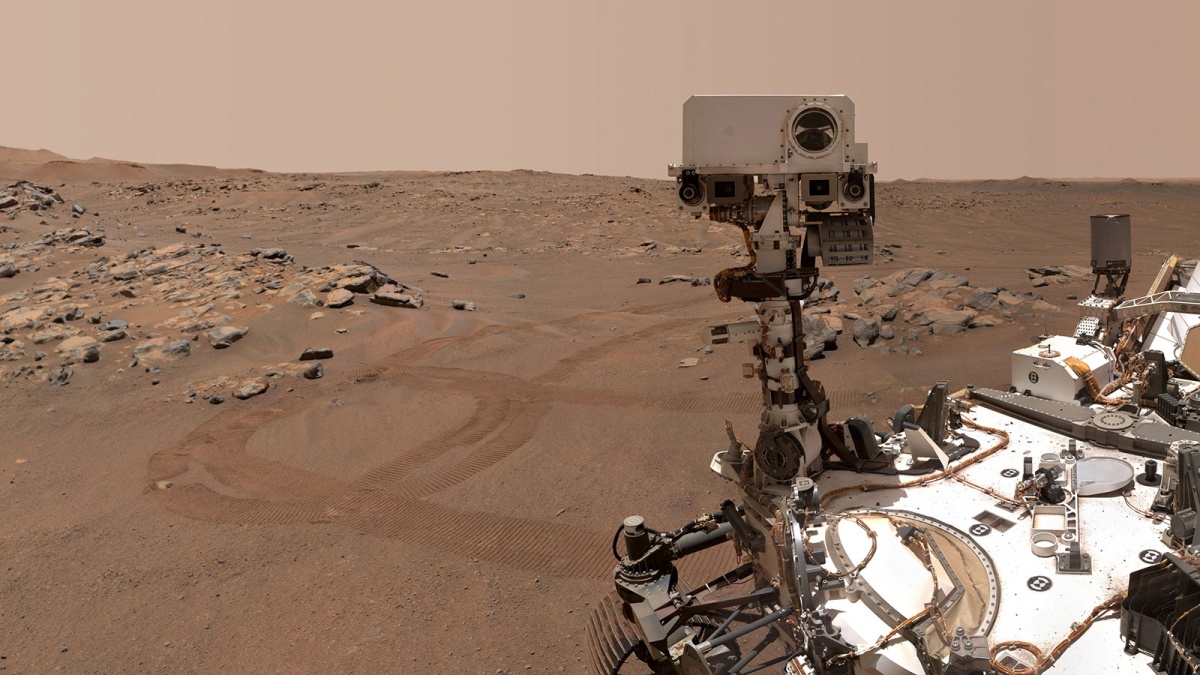NASA can now say what a dust devil sounds like on Mars. A NASA rover had its microphone on by chance when a whirling tower of red dust passed directly overhead, recording the racket.
It is about 10 seconds of not only rumbling gusts of up to 40kph (25mph), but the pinging of hundreds of dust particles against the rover Perseverance. Scientists released the first-of-its-kind audio Tuesday.
“We hit the jackpot” when the rover’s microphone picked up the noise made by the dust devil overhead, the study’s lead author Naomi Murdoch of the University of Toulouse, told AFP.
It sounded strikingly similar to dust devils on Earth, although quieter since the thin atmosphere on Mars makes for more muted sounds and less forceful wind, according to the researchers.
The dust devil came and went quickly last year, hence the short length of the audio, said Murdoch. At the same time, the navigation camera on the parked rover captured images, while its weather-monitoring instrument collected data.
“It was fully caught red-handed by Persy,” said co-author German Martinez of the Lunar and Planetary Institute in Houston.
Photographed for decades on Mars, but never heard, until now, dust devils are common on the red planet – especially in the Jezero crater, where the Perseverance rover has been operational since February 2021. But it had never before managed to record audio of them.
By chance on September 27, 2021, a dust devil 118 metres (390 feet) high and 25 metres wide passed directly over the rove, travelling at five metres (16 feet) per second.
The microphone picked up 308 dust pings as the dust devil whipped by, said Murdoch.
Given that the rover’s SuperCam microphone was turned on for less than three minutes every few days, Murdoch said it was “definitely luck” that the dust devil appeared when it did. She estimated there was just a 1-in-200 chance of capturing dust-devil audio.
Of the 84 minutes collected in its first year, there’s “only one dust devil recording”, she told the AP in an email from France.
“We hear the wind associated with the dust devil, the moment it arrives, then nothing because we are in the eye of the vortex,” said Murdoch, a planetary researcher at France’s ISAE-SUPAERO space research institute, where the SuperCam’s microphone was designed.
Then the sound returns “when the microphone passes through the second wall” of the dust devil, she added.
The impact of the dust made “tac tac tac” sounds, which will let researchers count the number of particles to study the whirlwind’s structure and behaviour, she said.
It could also help solve a mystery that has puzzled scientists. On some parts of Mars, “whirlwinds pass by sucking up dust, cleaning the solar panels of rovers along the way,” Murdoch said.
But in other areas, the whirlwinds move by without kicking up much dust. “They’re just moving air,” Murdoch said, adding that “we don’t know why.”
For example, the solar panels of NASA’s InSight lander are “covered in dust” because it is located at a spot where it cannot take advantage of these natural vacuum cleaners, she said.
Understanding why this happens could help scientists build a model of dust devils that could predict where the whirlwinds might strike next.
The same microphone on Perseverance’s mast provided the first sounds from Mars, namely the Martian wind, soon after the rover landed in February 2021. It followed up with audio of the rover driving around and its companion helicopter, little Ingenuity, flying nearby, as well as the crackle of the rover’s rock-zapping lasers, the main reason for the microphone.
These recordings allow scientists to study the Martian wind, atmospheric turbulence and now dust movement as never before, Murdoch said. The results “demonstrate just how valuable acoustic data can be in space exploration”.
Sylvestre Maurice, planetary scientist and co-author of the study published in the journal Nature Communications, said that analysing Martian dust makes it possible to “explore the interactions” between the ground and the extremely thin atmosphere.
The atmosphere was much thicker billions of years ago, which allowed for the presence of life-sustaining liquid water, said Maurice, who also works on the SuperCam.
“You might think that studying the Martian climate today is unrelated to the search for traces of life from billions of years ago,” he said.
“But it is all part of a whole, because the history of Mars is one of extreme climate change from a humid, hot planet to a completely arid and cold planet.”
On the prowl for rocks that might contain signs of ancient microbial life, Perseverance has collected 18 samples so far at Jezero Crater, once the scene of a river delta. NASA plans to return these samples to Earth a decade from now. The helicopter Ingenuity has logged 36 flights, the longest lasting almost three minutes.



